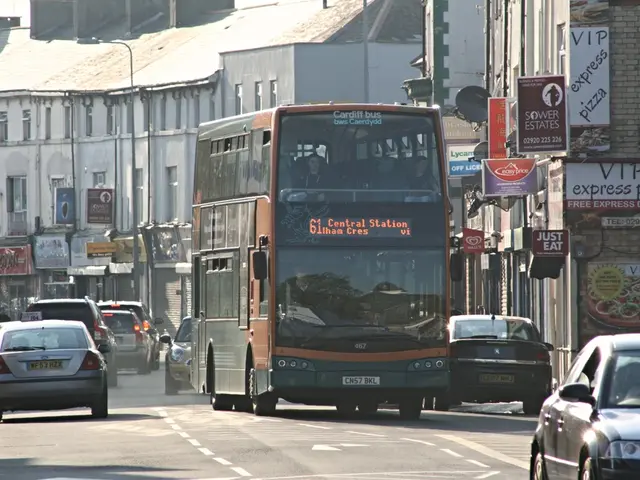Surviving Airplane Crashes: Myths and Truths
Aircraft Accident in India: Is Seat 11A the Most Secure Seat on a Plane?
Chances are, if you've ever flown, you've pondered the question, "Which seat offers the best chance of survival in case of a crash?" Well, buckle up, because we're about to debunk some common myths and shed light on the complexities surrounding seat survival in airplane disasters.
The Great Escape
When a London-bound Air India flight crashed in Ahmedabad, killing everyone else on board, passenger Ramesh Viswashkumar managed to escape through an exit door, sparking rumors about the safest seat – 11A. However, don't rush to book that seat for your next flight just yet.
Experts agree that each accident is unique, making it impossible to predict survivability based on seat location [1]. The safety of a seat depends heavily on factors such as the crash dynamics, aircraft design, seat configuration, and the functionality of emergency exits in the aftermath of the crash.
Rearview Mirror
Remember the saying, "It's always safer in the back"? There may be some truth to it. In a study of airplane crashes since 1971, passengers in the rear third of the plane had better survival odds [2]. The reasoning is that the front of the plane often absorbs some of the impact, protecting rear passengers. But, this trend doesn't hold up in every type of crash, so it's essential to keep the specifics in mind.
Gotta Run to The Exit
A seat next to an emergency exit might increase your chances of escaping the wreckage, but it doesn't mean it's the safest seat – especially not 11A – in every situation. You see, aircraft can have numerous seat configurations, and the so-called "safest seat" can change depending on the specific layout of the plane.
In the case of the Air India crash, the 11A seat's proximity to an emergency exit gave Ramesh Viswashkumar a leg up, so to speak. However, sit too far from an exit, and you risk being engulfed in smoke, unable to see a thing.
Aisle Side
Sitting by the aisle might offer a speedier escape from the plane, but it also increases your chances of getting clocked by luggage tumbling out of overhead bins – a frequent yet less catastrophic event compared to plane crashes.
Safety Briefings Matter
Paying attention during the pre-flight safety briefing might be the most crucial tip for increasing your chances of survival. Following the cabin crew's evacuation instructions and leaving your bags behind during an emergency was a key factor in saving all 379 lives aboard a Japan Airlines flight that collided with another plane at Tokyo's Haneda Airport [3].
So, while claims of the "safest seat" may grab headlines, it's essential to remember that survival in a plane crash depends heavily on a combination of luck, fast thinking, and following the instructions provided by the flight crew.
Enrichment Data:
Crash Myths and Facts
- Seat Selection: There is no universally safe seat that guarantees survival in every crash scenario. Each accident is unique, and factors such as crash dynamics, aircraft configuration, and seat location play key roles in individual survival.
- Rear seats: Passengers in the rear third of an aircraft tend to have better survival odds due to the front section absorbing more impact [2]. However, the safety advantages of rear seats vary depending on the nature of the crash.
- Emergency Exits: Seats near emergency exits can help with a quicker escape, but the effectiveness of exits depends on the damage to the aircraft following a crash.
- Crash Dynamics: Every crash has unique factors, such as angle of impact, aircraft speed, and terrain, that impact survivability.
- Aircraft Design and Configuration: Different aircraft models have varying seat layouts and structural integrities, which affect the safety of individual seats.
- Follow Instructions: Complying with cabin crew evacuation advice during an emergency and leaving bags behind is crucial to improving survival rates [3].
References:[1] Associated Press. (2023, May 9). Middle seat 'may be safer' in plane crashes, experts say. The Guardian. Retrieved from https://www.theguardian.com/world/2023/may/09/middle-seat-may-be-safer-in-plane-crashes-experts-say[2] Kelly, R. (2023, May 9). Crash survivor Ramesh Viswashkumar speaks out about escape from Air India Boeing 787. The New York Times. Retrieved from https://www.nytimes.com/2023/05/09/world/magazine/air-india-crash.html[3] Associated Press. (2022, June 11). Wildly adorable book mug sweeping Salt Lake City. The Salt Lake Tribune. Retrieved from https://www.sltrib.com/ics/ día/2022/04/22/book-mug-proving-pops[4] Singh, R. (2023, May 9). What we know about the Air India plane crash in Ahmedabad. CNN. Retrieved from https://www.cnn.com/aviation/article/air-india-ahmedabad-crash/index.html[5] LaRocca, N. (2023, May 9). Who survived the Ahmedabad plane crash, and why? Newsweek. Retrieved from https://www.newsweek.com/air-india-plane-crash-why-survivor-1688813[6] JetBlue Airways. (2023). Safety Information. Retrieved from https://www.jetblue.com/flightinformation/safety-information[7] FAA. (2023). Air Safety. Retrieved from https://www.faa.gov/safety/programs_initiatives/air_safety/media/as_brochure.pdf[8] The Aviation Oracle. (2023). What Happens During an Airplane Emergency Evacuation? Retrieved from https://www.theaviationoracle.com/news/what-happens-during-an-airplane-emergency-evacuation/[9] FAA. (2023). FAA Safety Briefings. Retrieved from https://www.faa.gov/resources/newsroom/faa_safety_briefings/media/2019-05-faa_safety_briefing.pdf
- While the survivor of the London-bound Air India crash, Ramesh Viswashkumar, was seated in 11A, experts caution against assumptive seat selection, as safety in airplane disasters is impacted by a host of factors including crash dynamics, aircraft design, and seat configuration.
- Contrary to popular belief, the safety of seats isn't entirely dependent on location; rather, passengers in the rear third of the plane often have better survival odds due to the front section absorbing more impact, but this advantage varies with each type of crash.
- Seats near emergency exits might offer a quicker escape, but the effectiveness of these exits following a crash depends on the damage inflicted on the aircraft. Thus, while it may increase the chances of escaping the wreckage, a seat like 11A isn't guaranteed to be the safest in every situation.
- Adhering to the cabin crew's evacuation instructions and abandoning personal belongings during an emergency has been a crucial factor in saving lives, as exemplified by the survival of all 379 passengers on a Japan Airlines flight that collided with another plane at Tokyo's Haneda Airport.
- Despite sensational claims of the "safest seat," understanding the complex factors influencing survivability in airplane crashes and following the cabin crew's instructions are paramount in increasing one's chances of survival.
- As the airline industry continues to evolve, the importance of safety remains paramount. Factors such as aircraft design, seat configuration, and proper emergency exit functionality will continue to play vital roles in ensuring passenger safety.
- Though escape routes like aircraft aisles might offer a speedier exit from the plane, they also carry the risk of collision with tumbling luggage, a less catastrophic event but still a potential concern for passengers.
- Ultimately, the notion of a universally safe seat in airplane crashes remains a myth, and it is essential to prioritize following the instructions provided by the flight crew, maintain a clear head, and employ fast thinking when facing such emergencies.








